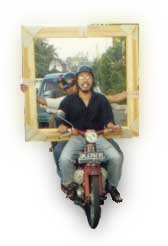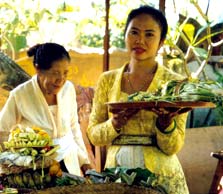

 |
Journey to Bali
One woman's journey to a new life
by Susan Gilbert
The story of a woman travelling in Bali--
struggling to understand the foreign culture
and beginning to understand herself.
| Bali had never been on my "Want to travel to" list. But when my cousin, who had been there the prior July, urged me to join her when she returned again this year, visions of a beautiful paradise danced in my head, and I enthusiastically said, "Yes".
My cousin, Diane, and I planned to meet at the Ngurah Rai Airport in Denpasar, Bali on July 4th -- arriving from separate destinations and flying separate routes. Indonesia was in upheaval at that time, and a travel advisory had been lifted only days before I left. Though I had traveled to Europe, I hadn't realized how long the trip was from San Diego to Denpasar and how far away I was traveling into the unknown. It took two days -- 23 hours of air travel with stops in Los Angeles, Tokyo, and Jakarta, before arriving in Denpasar. The short stop in Jakarta where all passengers were asked to deplane amongst armed guards, told me first hand that Bali, one of the many islands that make up Indonesia, could not be completely removed from the turmoil that was evident. So, in retrospect, I'm not sure how much of my disorientation was from the time changes and long travel versus what my eyes beheld. But, as I passed through customs and entered the baggage claim area to wait for my cousin's flight that was due to arrive within the hour, I was struck with the squalor and roughness. Indeed, I was in a foreign land and it didn't look like paradise. A young Asian man immediately hurried over to me and tried to whisk me outside to the many awaiting taxis that would take passengers to their destinations on the island. As I clutched my baggage in defense, he asked me How old are you, Are you married, Do you have any children, What is your name? I was soon to learn that these are the basic questions I would be asked by EVERY person I met over the next couple of weeks. It is the Balinese way to ask questions, and is not considered forward or rude. When I would not go with him, he sat next to me on a bench and continued to ask questions until I thankfully saw my cousin pass through the customs gate! Diane was familiar with Balinese etiquette on her prior trip, and after grabbing her own luggage and joining me, took me by the arm and pulled me outside through the masses of people. She began to have her own dialogue with the many drivers available then shoved me towards the taxi of her choice. I would soon learn that this is a country that despite the mile after mile of rice paddies is hungry economically and visitors mean money. Our taxi driver was grateful to be chosen and drove us safely and quickly to our destination town of Ubud where we found a home stay room, and promptly collapsed for the night. Not even the loud sounds of crocking frogs resounding in the night air could keep us from a deep night's sleep. The sun shown brightly in the morning sky when Diane excitedly took me by the When we popped out the other side of the forest, a bustling town of shops and restaurants showed Balinese families doing wood carving, making musical instruments, and stretching cloth over handmade drums. A very thin Barely one day into my adventure of Bali I was thinking, "This is not the paradise I had imagined." The magical journey I had held as a vision was dissolving. My cousin seemed oblivious as she swung her arms open wide, and said, "Isn't this wonderful? I'm so glad to be back!" The day was early, but the sun was already high in the sky, and the temperature felt like it was already in the 90's. We stopped at what is a typical day spa called Bodywork Centre, and requested a Mandi Lulur which is a full body massage followed by a body exfoliation scrub with a herbal cream and a yogurt rub down. We then soaked in outdoor baths with scented spices and flowers and left two hours later refreshed and rejuvenated. We stopped at a local restaurant and lunched on a salad made of the freshest, most unusual combination of greens I couldn't even name. Our host explained the r Back on the street again, jangling noise that is Balinese music called gamelan, a clashing of syncopated sounds which seemed to me to have no melody, poured out the buildings. Yet by nightfall, as I watched the Balinese dancers with their rapid eye and hand movements, adorned in intricate and colorful costumes, moving to the banging of the drums, gongs and cymbals, I began to hear the flow that was created by an unusual mixture of tones. What at first had sounded like confusion, I later learned is highly structured compositions that are produced by a group of 25 or more highly trained musicians seated cross-legged on the ground at a variety of bronze percussion instruments. On Bali, rituals and ceremonies are carried out at important points in an And then over the next few days, I began to notice other things. Everyone was smiling. Mothers and fathers worked with creativity and their children at their side. I learned later that the Balinese learn artistic crafts very quickly by first entering into the interior sense of "being" a complex dance, a mask, a statue, a painting and only then express what they "are" in physical form. These highly skilled carvers, sculptors, weavers and painters create as their unquestioned duty to honor their gods. Their spirituality is a force that determines their complete existence. I found myself moving into a state of being that was more foreign to me than the land I was in. I was learning the magic of Bali. I began to ask myself, How would I live differently if I chose the work of my life to be in honor of God? What would my work be? As a small business owner, my work had always been done to provide myself a living. What if my work became about being who I am? It was about this time, several days into my visit to Bali, that Diane began to ask around town for recommendations for a Balinese jeweler who could reset a stone of hers into a pendant that incorporated the Bali ohm. We were at our cooking class when a classmate suggested we contact a couple named Jane and Andi who did beautiful and original jewelry design work. Jane, who is American and Andi, who is from Switzerland, live in a typical Bali compound style home that consists of several structures all built within a confining wall. Given the climate, most domestic activities take place outside or in the partial shelter of raised platforms supported by pillars and a roof traditionally thatched with local grass. Every compound has their family temple with a main shrine and many other shrines can be built within the compound for different purposes. When we met Jane and Andi, they had just built a shrine dedicated to the safety of their compound and placed in an area that was believed to be lacking in good energy. Diane and I quickly found that Jane and Andi were the natural choice to create Diane's pendant, and became welcome visitors to their home during the creation. It was during this time that the new shrine was completed, and we were invited to participate in the blessing ceremonies provided by the local priests. As we prayed, ate and celebrated together -- all people from different lands yet really all the same, it occurred to me that a pendant that represented this oneness would be very meaningful to me. The rest is history. Jane, Andi and I created the Unity pendant, and the result of this vision can be found at www.one-gallery.com. Bali had at first seemed so foreign. Slowly it called to me with new sights, new sounds, new beliefs -- until it had become all one experience -- an experience in being. With this realization, life as I knew it had changed, and I knew I had found much more in Bali than a new land. I had learned a new way of living.
About the Author: Susan Gilbert is author and entrepreneur. Her relationship with Jane and Andi led to the successful formation of
one-gallery, www.one--gallery.com, located in San Diego, CA. The
jewelry is artistic in design and high in quality. Susan
has written an inspirational gift book. Go to Creational
Books to find out more...." |

 Bali lies nestled amidst thousands of islands that straddle the equator to form the Indonesian Archipelago. It is a relatively small island, approximately 5,000 square kilometers in area, with about three and a half million inhabitants. The terrain is largely mountainous, with volcanic activity in evidence, and the coastline is surrounded by strong currents and many reefs. These features perhaps deterred unwelcome intruders in earlier times, thereby helping to preserve this ancient culture. Now we arrive by air and Bali has changed.
Bali lies nestled amidst thousands of islands that straddle the equator to form the Indonesian Archipelago. It is a relatively small island, approximately 5,000 square kilometers in area, with about three and a half million inhabitants. The terrain is largely mountainous, with volcanic activity in evidence, and the coastline is surrounded by strong currents and many reefs. These features perhaps deterred unwelcome intruders in earlier times, thereby helping to preserve this ancient culture. Now we arrive by air and Bali has changed. arm and walked me through the Monkey Forest and into town, a walk that would repeat daily throughout the trip. Here in the Monkey Forest were hundreds of monkeys -- hanging in the trees, walking with us along the dirt road, peering at us from the walls of an ancient temple. Their families were all around us. Babies held on tight with arms clasped around mother's neck and leg wrapped around her body as she ran along the forest line chattering at us.
arm and walked me through the Monkey Forest and into town, a walk that would repeat daily throughout the trip. Here in the Monkey Forest were hundreds of monkeys -- hanging in the trees, walking with us along the dirt road, peering at us from the walls of an ancient temple. Their families were all around us. Babies held on tight with arms clasped around mother's neck and leg wrapped around her body as she ran along the forest line chattering at us.  , old man held out a carved wooden Buddha to me, and urged me to buy calling out "seventy, seventy". He would sell it to me for seventy rupiah. He rubbed his belly, indicating he was hungry. I bought the Buddha. The narrow streets made passage of cars a one at a time free for all, with motor bikes, the more common mode of transportation -- weaving crazily in and out. People of all ages rode the motor bikes, two at a time, juggled their packages and held onto their children. Removing ourselves from the bustle, we stopped at small outdoor café and ordered hot tea. The pot of hot water arrived with fresh lemon grass bent in half and left in the pot, along with slices of fresh ginger. As I sipped this warm and refreshing liquid, I looked out at the view of the street in front of me and reflected that the town seemed dusty and dirty. The people seemed poor. Everyone wanted us to buy something, and again I was struck by the poverty of the country.
, old man held out a carved wooden Buddha to me, and urged me to buy calling out "seventy, seventy". He would sell it to me for seventy rupiah. He rubbed his belly, indicating he was hungry. I bought the Buddha. The narrow streets made passage of cars a one at a time free for all, with motor bikes, the more common mode of transportation -- weaving crazily in and out. People of all ages rode the motor bikes, two at a time, juggled their packages and held onto their children. Removing ourselves from the bustle, we stopped at small outdoor café and ordered hot tea. The pot of hot water arrived with fresh lemon grass bent in half and left in the pot, along with slices of fresh ginger. As I sipped this warm and refreshing liquid, I looked out at the view of the street in front of me and reflected that the town seemed dusty and dirty. The people seemed poor. Everyone wanted us to buy something, and again I was struck by the poverty of the country.  easoning behind their menu. The Balinese religion, officially known as Hindu Dharma, is a subtle blend of Animism, Hinduism, and Buddhism. Traditional Balinese food is an important aspect of this culture. It is surrounded by complex customs related to the meaning of food, the function of food, and the distinct value systems of the people. Connected with this concept of food are rules and regulations concerning what may or may not be eaten according to subject, space, time, and situation. Eating began to take on new meaning. We decided to return later in the week to attend a cooking class and learn how to prepare this food for ourselves.
easoning behind their menu. The Balinese religion, officially known as Hindu Dharma, is a subtle blend of Animism, Hinduism, and Buddhism. Traditional Balinese food is an important aspect of this culture. It is surrounded by complex customs related to the meaning of food, the function of food, and the distinct value systems of the people. Connected with this concept of food are rules and regulations concerning what may or may not be eaten according to subject, space, time, and situation. Eating began to take on new meaning. We decided to return later in the week to attend a cooking class and learn how to prepare this food for ourselves. individual's life to purify them, and make sure they have sufficient spiritual energy to remain healthy and calm. And every day, the Balinese give thanks. For what appears at first to be a country that is poor by our western standards, they give thanks to their gods every day and live in a state of complete acceptance and gratitude. There is no work ethic, as we know it, where they work for the purpose of earning money. They work with joy and create with love. They work when they want to work, and celebrate -- which they do often -- with parades leading down the main thoroughfares into the temples.
individual's life to purify them, and make sure they have sufficient spiritual energy to remain healthy and calm. And every day, the Balinese give thanks. For what appears at first to be a country that is poor by our western standards, they give thanks to their gods every day and live in a state of complete acceptance and gratitude. There is no work ethic, as we know it, where they work for the purpose of earning money. They work with joy and create with love. They work when they want to work, and celebrate -- which they do often -- with parades leading down the main thoroughfares into the temples.